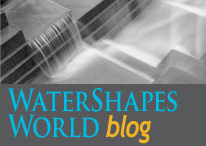engineering
As purveyors of fountains and other forms of decorative or recreational water, watershapers are faced these days by an immediate challenge: What we do is generally classified as "unsustainable" by an environmentally conscious public because they erroneously assume poor performance when it comes to the way we approach water consumption, use of space and energy efficiency. On the surface, these are serious knocks on
I'd hazard the guess that most experienced pool designers and builders have run into this scenario: The clients want a pool, and they also want a spa - but not just any spa will do. Through the years, these clients have been in the attached spas of friends' inground concrete pools, but this is not what they want. That's because they've also experienced portable spas and prefer their performance: superior jet action, diverse seating arrays and options, more features and
Sometimes, things come together in just the right way. I'd been called in to a multimillion-dollar property with a large, three-year-old house on it, right next to the Chattahoochee River on the northwestern fringe of Atlanta. There was an existing pool, but the homeowners wanted something new - a composition that befitted the home's elegance and said more about
During last summer's Olympic Games in Rio de Janeiro, the swimming pools attracted an amazing amount of attention. Unfortunately, it was only partly because of the outstanding in-pool performances offered up by swimmers, water-polo teams and divers - a feast of excellence that will
Pebble Technology (Scottsdale, AZ) has added 100-percent copper scuppers to its Fire+Water Elements line. Engineered…
As watershapers, we're comfortable using our chosen medium as a place-maker, an entertainer and a resource for recreation. In doing so, we take advantage of the fact that water is a unique, extremely versatile substance that can be manipulated in innumerable ways. We also accommodate the thought that, supreme among design media, water has a pronounced and often profound effect on people who
It's not all that often that I use WaterShapes World to discuss a specific item appearing in our current newsletter, but this time I can't resist: The first in a series of three great articles appears in this edition, and I want to call as much attention to it as I can. In my last blog (click here), I wrote about the important lessons water-oriented professionals have learned through coping with


















